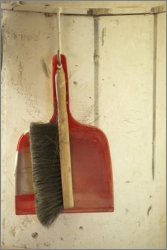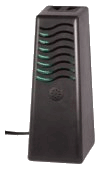The Little-Known Dangers of Dust ...
and What You Can Do About It
by www.SixWise.com
It collects on our nightstands and dressers, makes "bunnies" under the bed, and settles easily into everything from upholstery to houseplants ... but aside from being unsightly (and a bother to clean up) is there really anything so bad about dust?
|

Dust may seem harmless enough, but that's only until you find out what's in it (see the shocking list below)!
|
Quite frankly, yes. And it's not just dust mites that are the problem.
Making up the seemingly innocuous dust in your home is a complex mixture of pet dander, fungal spores, particulates from indoor aerosols, soil, VOCs, traces of metals, shed human cells, mold spores and even chemicals like flame retardants, PCBs and paint.
Because all of this accumulates over time, many experts refer to house dust as an "indoor-pollution archive" or a "long-term accumulative sample" of contaminants, according to the Environmental Working Group (EWG).
Worse still, because dust is not normally exposed to moisture and sunlight, the contaminants within break down very slowly, if at all. This is why the pesticide DDT has been found in 65 percent of dust samples collected in Massachusetts homes, despite being banned since the 1970s.
What All is in Your Home's Dust?
According to a compilation of three studies reported by the Environmental Working Group, "house dust is a reservoir for many environmental toxins." The studies found concentrations of the following chemicals in house dust:
Fire Retardants
- TBBPA, tetrabromobisphenol A
- HBCD, hexabromocyclododecane
- Tris breakdown product, 2,3-dibromo-1-propanol
Plastics Additives
- bisphenol A
- dibutyltin
- dioctyltin
- monobutyltin
- monooctyltin
- tributyltin
PVC Plastic, Personal Care Product Additives
- benzyl butyl phthalate
- bis(2-ethylhexyl) adipate
- bis(2-ethylhexyl) phthalate
- diethyl phthalate
- di-N-butyl phthalate
|

If you're dusting with ordinary cloths and dusters, all you're doing is pushing the dirt around (or stirring it up into the air). Keep reading for a superior dusting option.
|
Pesticides
- bendiocarb
- carbaryl
- chlorpyrifos
- diedrin
- DDT
- methoxychlor
- pentachlorophenol
- piperonyl butoxide
- trans-permethrin
Food and Cosmetics Preservative
Industrial Detergent, Chemicals in Personal Care Products
- 4-nonylphenol
- nonylphenol diethoxylate
- nonylphenol monoethoxylate
Other unsavory elements common in household dust include:
- Cigarette smoke (and its byproducts)
- Fabric fibers from your clothing and carpets
- Sand and soil particles
- Plant and insect parts
- Viruses
- Rodent waste
- Construction debris (adhesives, sawdust, etc.)
- Pollen
- Bacteria
- Asbestos
Is Dust Really Dangerous?
When you walk around or vacuum, dust particles are stirred up into the air, and along with them come the slew of potential toxic chemicals and other unsavory items like rodent waste and insect parts. You may then breathe in these particles or absorb them through your skin once they settle back down onto a surface you touch.
Since Americans spend 90 percent of their time indoors, there's plenty of time to be around this potentially toxic dust. This is especially concerning if you have small children or infants. Children who crawl and put their fingers in their mouth can ingest 10 grams of dust per day. And, since they're smaller than adults and their systems are still developing, they are at a higher risk from contaminants.
On average, infants and toddlers ingest about twice as much dust as adults per day, according to EWG. And the EPA suggests that children ages 1 to 4 consume about 100 mg of dust a day, and 400 mg for highly exposed children. When you think about the laundry list of toxins that could be in that dust, you begin to see where the risk arises.
Allergies, asthma, itchy eyes, coughing and runny noses aside, the specific health effects of house dust depend on which contaminants are in the dust, as well as the levels and how long you have been exposed. In the case of flame retardants (PBDEs), for example, which one U.S. study found were present in every home they tested, they could affect brain development and reproductive hormones.
|
 The top-recommended Pionair Air Treatment System utilizes "photocatalysis" technology to purify your indoor air, a process that replicates nature's own method of purifying the air outside. The top-recommended Pionair Air Treatment System utilizes "photocatalysis" technology to purify your indoor air, a process that replicates nature's own method of purifying the air outside.
Virtually all leading health organizations and health experts recommend air purifying systems for the home, so if you are in the market we urge you to consider the top-rated Pionair ... right now you can take advantage of a very special (but limited time!) offer!
Read More About the PIONAIR Now!
|
And if you think simply inhaling dust isn't enough of an exposure, the researchers found that two-thirds of the PBDEs present in adults' bodies seem to be coming from household dust. In the case of infants, some 90 percent of their PBDE body level came from house dust.
The TOP Method to Reduce Harmful Dust in Your Home
According to many leading health organizations including the American Lung Association, with the growing knowledge of air pollution in the home, it has become clear that every home needs an air purifier. But with the multiple varieties available, and the big-dollar push behind certain brands, many people are unclear as to what the best type is for their home.
The most effective air purifying technology called "photocatalysis" -- which is the technology used in the PIONAIR™ Air Treatment System that we highly recommend and therefore now offer to you -- is, in summary, a replication of how outdoor air is naturally purified.
|
Eliminate Dust With PerfectClean's Complete Mop and Dusting Kit
PerfectClean is the line of cleaning tools that leading hospitals and healthcare organizations use for several reasons:
-
The ultramicrofiber construction picks up far more dust, dirt and biological contaminants than any other cleaning tool, so your home is significantly cleaner
-
Unlike chemical cleaners and typical mops and sponges which are loaded with germs, PerfectClean products are 100% safe due to their ultramicrofiber construction
-
Hospitals and other organizations use them a hundred times or more ... so they will save you money as you can eliminate chemical cleaners and avoid constantly replacing towels, mop heads, etc.
-
Ergonomic design - industrial durability but ultra-lightweight and ergonomic design makes cleaning faster and more efficient while eliminating strain on your back and body!
Includes:
- One (1) EasyGrip 16" Wide Flat Mop System w/Ergonomic Handle
- Two (2) Flat Mop Heads
- One (1) Flexible Duster
- Two (2) Duster Covers
Due to the positively charged ultramicrofibers, these mops and dusters pick up everything in their path including dust, crumbs, pet hair, lint and contaminants invisible to the naked eye. Use them wet or dry -- only water is needed!
The EasyGrip Mop and Flexible Duster are made with the finest, most-durable ultramicrofiber material -- they can be washed OVER 100 TIMES before replacing them. This is not only the most effective mopping/system you will find anywhere, but it is also the most cost-effective!
|
Ions are electronically charged particles that are positive or negative and occur naturally. There is an "ideal balance" that nature maintains in the outdoor air. The ratio is approximately 6 positive ions to 5 negative ions. Indoors, this ratio is thrown off balance because of the abundance of positive ions and the lack of negative ions.
This disruption of the natural balance is primarily caused by building materials used in the structures in which we spend 90% of our time. The negative ion gives up its charge to the pollutants such as dust, pollen, bacteria, smoke, and formaldehyde. This new negative particle attracts positive particles until they become heavy enough to fall out of the air we breathe. This process is called "agglomeration."
The PIONAIR™ Air Purifying system's "photocatalysis" technology produces negative ions thereby reducing these and other particles in the air. The Pionair is not an "air filter" but truly an air purifier that duplicates nature's own methods of air cleaning and revitalization!
The Second Essential Method to Keep Dust Away
Dusting horizontal and other surfaces regularly is necessary to get dust out of your home -- but an ordinary dust cloth, the kind that just moves dust around, won't do.
What's the optimum choice for dusting? The PerfectClean line of mops, dusters, towels and more, which are used by leading hospitals and other healthcare organizations. Rather than just pushing dust around, or worse, stirring it up into the air, PerfectClean products are made with positively charged ultramicrofibers that pick up everything in their path -- including dust and all of its microscopic attachments. These ultramicrofibers are so small at an astonishing 3 microns that they're even smaller than most bacteria (each cleaning cloth contains over 300 miles of actual cleaning surface!). They pick up contaminants either used dry or dampened with water-no harsh cleaners needed.
Choosing PerfectClean's ultramicrofiber cloths, mops and wipes is by far the smartest choice -- and the most economical since each cloth can be used over 100 times before being replaced -- for dusting in your home.
Though it's impossible to not have ANY dust in your home, by using an air purifier and dusting your home regularly with PerfectClean you will be able to keep dust, and therefore your risk of related illness, to a minimum.
One final solution you can try to further minimize dust in your home is to get rid of your carpeting. Carpet is a perfect place for dust to cling to, and it even produces dust of its own (from the fibers). Opting for hardwood floors with scattered rugs, which should be washed in hot water weekly, is the optimum dust-reducing choice.
Recommended Reading
12 Steps to Making Your Home an Asthma-Safe Environment
Health Threats from Air Pollution Greater for Diabetics
Sources
Environmental Working Group, Dust and Indoor Pollution